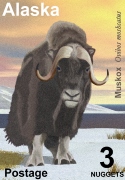There are some people in Alaska who would like for the state to become an independent nation. And there are a few who seem to think Alaska is already independent. So, I have another entry in the series of postage stamps for an independent Alaska. This time a 10-Nugget featuring a bull Caribou superimposed on a Caribou pelt.

10-Nuggest Alaska Postage Stamp
While Caribou (Rangifer tarandus), known as the reindeer outside of North America, are widespread and numerous, some subspecies are rare and one has gone extinct. The Inuit word tuktu means – deer that never stops moving. Caribou are always on the move, going north to calve, heading for the winter grounds, and south in the summer. Caribou considerably in colour and size. Uniquely among deer, both genders grow antlers, though these are larger in the males and there are a few populations where females lack them completely.
Caribou hunting and herding of semi-domesticated reindeer (for meat, hides, antlers, milk and transportation) are important to several Arctic and Subarctic peoples. Even far outside its range, the caribou/reindeer is well known due to the myth, probably originating in early 19th century America, in which Santa Claus’s sleigh is pulled by flying reindeer. In Lapland (aka Samiland) reindeer pull a pulks, a type of sled or sleigh.
Caribou are present in both tundra and taiga (boreal forest) areas. It was originally was found in Scandinavia, eastern Europe, Russia, Mongolia, and northern China north of the 50th latitude. In North America, it was found in Canada, Alaska, and the northern conterminous USA from Washington to Maine. In the 19th century, it was apparently still present in southern Idaho. It also occurred naturally on Sakhalin, Greenland, and probably even in historical times in Ireland.
During the late Pleistocene era, reindeer were found as far south as Nevada and Tennessee in North America and Spain in Europe. Domesticated reindeer are mostly found in northern Fennoscandia and Russia, with a herd of approximately 150-170 reindeer living around the Cairngorms region in Scotland. The last remaining wild tundra reindeer in Europe are found in portions of southern Norway. A few reindeer from Norway were introduced to the South Atlantic island of South Georgia in the beginning of the 20th century. Today, there are two distinct herds still thriving there, permanently separated by glaciers. Their total numbers are no more than a few thousand. The flag and the coat of arms of the territory contain an image of a reindeer. Around 4000 reindeer have been introduced into the French sub-Antarctic archipelago of Kerguelen Islands. East Iceland has a small herd of about 2500–3000 animals.
Caribou and reindeer numbers have fluctuated historically, but many herds are in decline across their range. This global decline is linked to climate change for northern, migratory caribou and reindeer herds and industrial disturbance of caribou habitat for sedentary, non-migratory herds.
Fur Fur color varies considerably, both individually, and depending on season and subspecies. Northern populations, which usually are relatively small, are whiter, while southern populations, which typically are relatively large, are darker. This can be seen well in North America, where the northermost subspecies, the Peary Caribou, is the whitest and smallest subspecies of the continent, while the southermost subspecies, the Woodland Caribou, is the darkest and largest.
The coat has two layers of fur, a dense woolly undercoat and longer-haired overcoat consisting of hollow, air-filled hairs.
In most populations both sexes grow antlers, which (in the Scandinavian variety) for old males fall off in December, for young males in the early spring, and for females in the summer. The antlers typically have two separate groups of points, a lower and upper.
Caribou have the largest antlers relative to body size among deer, but the antlers of the domesticated reindeer antlers tend to be rather small and spindly.
Caribou are primarily dependent on lichens for food during the winter, especially reindeer moss. They also consume the leaves of willows and birches, as well as sedges and grasses. There is some evidence to suggest that on occasion, they will also feed on lemmings, arctic char, and bird eggs. Reindeer herded by the Chukchis have been known to eat mushrooms.
Some populations of North American caribou the longest migration route of any terrestrial mammal, traveling up to 3,100 mi (5,000 km) a year, and covering 390,000 sq mi 1,000,000 km2 (1,000,000 km2).
There are a variety of predators that prey heavily on reindeer. Golden Eagles prey on calves and are the most prolific hunter on calving grounds. Wolverine will take newborn calves or birthing cows, as well as (less commonly) infirm adults. Brown Bear and, occasionally, Polar Bear prey on reindeer of all ages but (as with the wolverine) are most likely to attack weaker animals such as calves and sick deer. The Gray Wolf is the most effective natural predator of adult reindeer, especially during the winter.
Blood-sucking insects, such as black flies and mosquitoes, are a plague to reindeer during the summer and can cause enough stress to inhibit feeding and calving behaviors.
Caribou and Reindeer have long been hunted by humans since the Mesolithic and Neolithic periods, and are today the main predator in many areas. Norway and Greenland have unbroken traditions of hunting wild reindeer from the ice age until the present day. In the non-forested mountains of central Norway it is still possible to find remains of stone-built trapping pits, guiding fences, and bow rests, built especially for hunting reindeer.
Caribou are still hunted in North America and Greenland. In the traditional lifestyle of the Inuit people, Northern First Nations people, Alaska Natives, and the Kalaallit of Greenland, the caribou is an important source of food, clothing, shelter, and tools. Many Gwichʼin people, who depend on the Porcupine caribou, still follow traditional caribou management practices that include a prohibition against selling caribou meat and limits on the number of caribou to be taken per hunting trip.





























